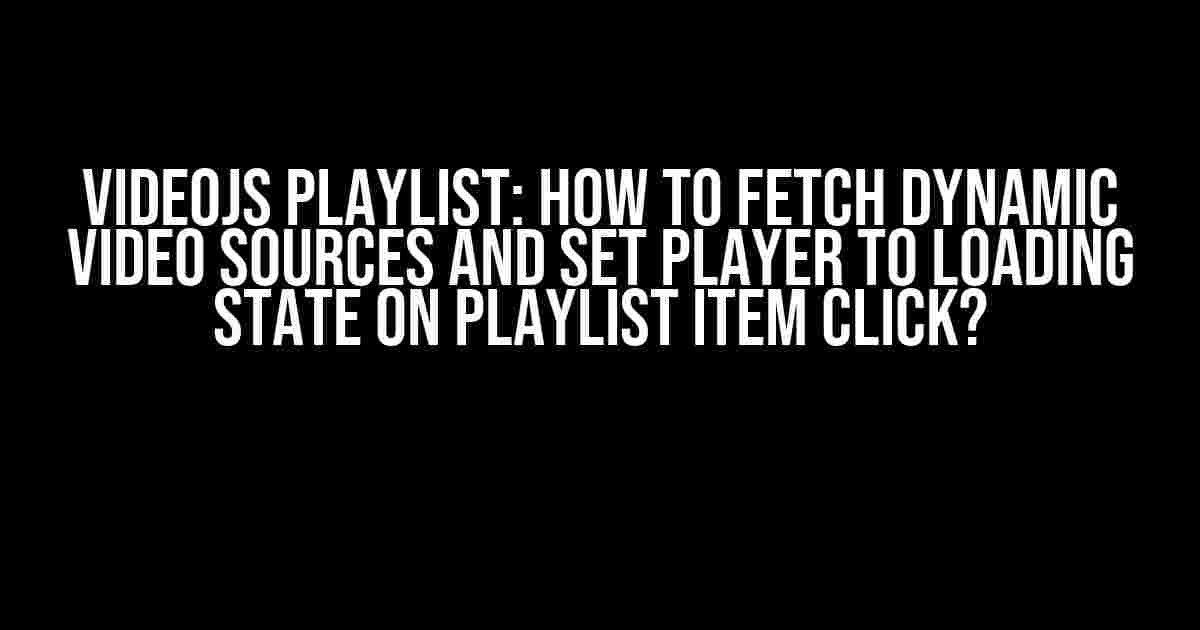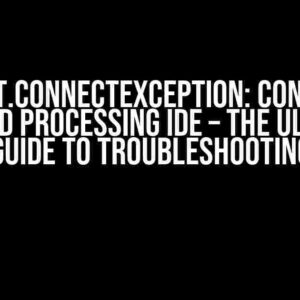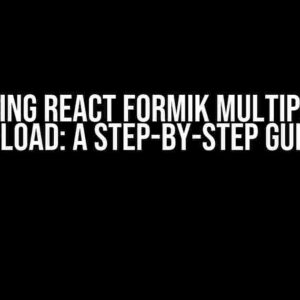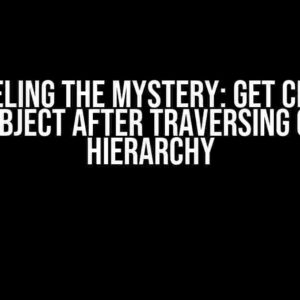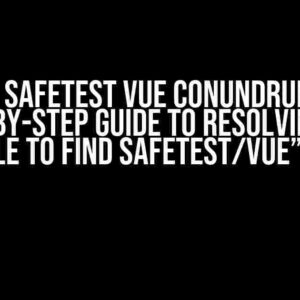Are you tired of dealing with static video sources in your VideoJS playlist? Do you want to take your video player to the next level by fetching dynamic video sources and setting the player to a loading state on playlist item click? Look no further! In this article, we’ll take you on a step-by-step journey to achieve just that.
What is VideoJS?
VideoJS is a popular, open-source JavaScript library used to create customizable video players for the web. It’s widely used by developers and websites around the world to create engaging video experiences. VideoJS provides a robust framework for building video players, including support for multiple video formats, responsive design, and customizable skins.
What is a VideoJS Playlist?
A VideoJS playlist is a collection of video sources that can be played in a VideoJS player. A playlist can be static, where the video sources are hardcoded, or dynamic, where the video sources are fetched from an external API or database. In this article, we’ll focus on creating a dynamic VideoJS playlist that fetches video sources from an external API.
Fetching Dynamic Video Sources
To fetch dynamic video sources, we’ll use the VideoJS playlist API to make an AJAX request to an external API. In this example, we’ll use a fictional API that returns a JSON response containing an array of video sources.
// Define the API endpoint and video sources array
const apiEndpoint = 'https://example.com/api/videos';
let videoSources = [];
// Make an AJAX request to the API endpoint
fetch(apiEndpoint)
.then(response => response.json())
.then(data => {
videoSources = data.videos;
});
In the above code, we define the API endpoint and an empty array to store the video sources. We then make an AJAX request to the API endpoint using the fetch API, and parse the JSON response using the `.json()` method. The video sources are stored in the `videoSources` array.
Creating the VideoJS Playlist
Now that we have the video sources, let’s create a VideoJS playlist and add the video sources to it.
// Create a new VideoJS player instance
const player = videojs('my-player');
// Create a new VideoJS playlist instance
const playlist = player.playlist();
// Add the video sources to the playlist
videoSources.forEach(video => {
playlist.addItem({
sources: [{
src: video.src,
type: video.type
}]
});
});
In the above code, we create a new VideoJS player instance and a new VideoJS playlist instance. We then add the video sources to the playlist using the `addItem()` method, which takes an object with a `sources` property containing an array of video sources.
Setting the Player to Loading State on Playlist Item Click
To set the player to a loading state on playlist item click, we’ll use the VideoJS playlist API to listen for the `beforechange` event. This event is triggered when the user clicks on a playlist item.
// Listen for the beforechange event
playlist.on('beforechange', () => {
// Set the player to a loading state
player.loading Spin(true);
});
In the above code, we listen for the `beforechange` event using the `on()` method, and set the player to a loading state using the `loadingSpin()` method. This will display a loading spinner on the player, indicating that the video is loading.
Full Example Code
Here’s the full example code that fetches dynamic video sources and sets the player to a loading state on playlist item click:
<!-- Create a VideoJS player container -->
<div id="my-player"></div>
<!-- Fetch dynamic video sources from API -->
<script>
const apiEndpoint = 'https://example.com/api/videos';
let videoSources = [];
fetch(apiEndpoint)
.then(response => response.json())
.then(data => {
videoSources = data.videos;
// Create a new VideoJS player instance
const player = videojs('my-player');
// Create a new VideoJS playlist instance
const playlist = player.playlist();
// Add the video sources to the playlist
videoSources.forEach(video => {
playlist.addItem({
sources: [{
src: video.src,
type: video.type
}]
});
});
// Listen for the beforechange event
playlist.on('beforechange', () => {
// Set the player to a loading state
player.loadingSpin(true);
});
});
</script>
Conclusion
In this article, we’ve demonstrated how to fetch dynamic video sources and set the player to a loading state on playlist item click using VideoJS. By following these steps, you can create a dynamic VideoJS playlist that loads video sources from an external API and provides a seamless user experience.
| API Endpoint | https://example.com/api/videos |
|---|---|
| Video Sources Array | videoSources |
| VideoJS Player Instance | player |
| VideoJS Playlist Instance | playlist |
I hope you found this article helpful! If you have any questions or need further assistance, please don’t hesitate to reach out.
Happy coding!
Here are 5 questions and answers about “VideoJS Playlist: How to Fetch Dynamic Video Sources and Set Player to Loading State on Playlist Item Click”:
Frequently Asked Question
Get answers to your burning questions about VideoJS Playlist and dynamic video sources!
What is the best way to fetch dynamic video sources in VideoJS Playlist?
To fetch dynamic video sources in VideoJS Playlist, use the `playlist.item` function to get the current playlist item, and then use the `videojs.Player.src` function to set the source of the video player. You can also use the `playlist.currentItem` property to get the current playlist item and then fetch the video source using an AJAX request or any other method that suits your needs.
How do I set the player to a loading state when a playlist item is clicked?
To set the player to a loading state when a playlist item is clicked, you can use the `player.loading` function and pass `true` as an argument. You can also use the `player.poster` function to set a loading poster image. Additionally, you can use the `playlist.on` function to listen to the `playlistitemclick` event and then set the player to a loading state when the event is triggered.
Can I use a JSON file to store dynamic video sources for my VideoJS Playlist?
Yes, you can use a JSON file to store dynamic video sources for your VideoJS Playlist. Simply create a JSON file that contains an array of video sources, and then use JavaScript to fetch the JSON file and populate the playlist with the video sources. You can use the `JSON.parse()` function to parse the JSON file and then loop through the array to add the video sources to the playlist.
How do I handle errors when fetching dynamic video sources in VideoJS Playlist?
To handle errors when fetching dynamic video sources in VideoJS Playlist, you can use try-catch blocks to catch any errors that may occur when fetching the video sources. You can also use the `player.error` function to handle errors that occur when the video player encounters an error while playing the video. Additionally, you can use the `playlist.onError` function to handle errors that occur when the playlist encounters an error while loading the video sources.
Can I use a callback function to set the player to a loading state when a playlist item is clicked?
Yes, you can use a callback function to set the player to a loading state when a playlist item is clicked. Simply pass a callback function to the `playlist.on` function when listening to the `playlistitemclick` event. The callback function will be executed when the event is triggered, and you can set the player to a loading state within the callback function.

